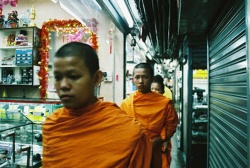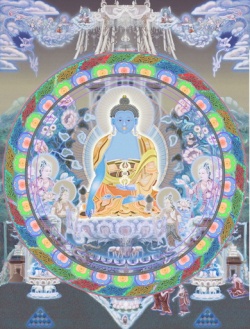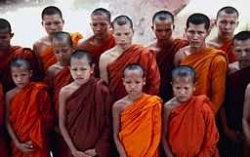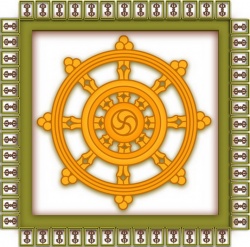Mingyur Rinpoche, the millionaire monk who renounced it all
by Mary Finnigan guardian.co.uk, Thursday 22 September 2011 12.39 BST
Homage to Mingyur Rinpoche, he who has fearlessly followed the Buddha's example to take to a homeless, wandering life. May he attain the supreme siddhi and return to share his insights with all of us The Buddhist teacher's decision to leave his monastery suggests a revival of the principles laid down by the Buddha .
On first impression, Mingyur Rinpoche seemed to have everything well set up for a high profile career as a globe-trotting meditation teacher in the Kagyu tradition of Tibetan Buddhism. The youngest of three sons of the late, much venerated Tulku Urgyen, by the age of 36 he had a bestselling book (The Joy of Living) to his name, a monastery in India and Tergar, an international organisation based in the US with branches worldwide.
Mingyur Rinpoche was living comfortably with a retinue of attendants. He was in high demand as a teacher and admired by developed world devotees in particular, for his interest in the scientific implications of meditation – specifically its effect on brain function and the nervous system. He already had 10 years of solitary meditation retreat behind him and Tibetan Buddhist aficionados were impressed with his personal qualities.
But Mingyur Rinpoche was not content to rest on his laurels. Nor was he interested in becoming yet another celebrity guru, living in luxury and spoiled by the adulation accorded to important lamas. One morning in June this year his attendants knocked on the door of his room at his monastery in Bodhgaya, India, and when there was no response they went in to find it empty – except for a letter explaining that he had left for an indeterminate period to become a wandering yogi, meditating wherever he alighted in the Himalayas.
"He took no money, and no possessions," explained his brother Tsoknyi Rinpoche. "He didn't take his passport, his mobile phone or even a toothbrush."
In his letter Mingyur Rinpoche said that from a young age he had "harboured the wish to stay in retreat and practise, wandering from place to place without any fixed location". He advised his followers not to worry about him, assuring them that in a few years they would meet again. To this day no one has any idea of his whereabouts and he has not been in touch with his family.
Mingyur Rinpoche (the title Rinpoche means Precious One) left on his journey from Bodhgaya, the place where the historical Buddha Siddhartha attained enlightenment.
"There's an interesting parallel with the Buddha," says Donald Lopez, professor of Buddhist and Tibetan studies at the University of Michigan. "Since the fall of the Tibetan monarchy in 842, incarnate lamas have served as a kind of aristocracy in Tibet, so a high-ranking tulku is not unlike a prince. Mingyur Rinpoche has renounced royal life, just as Prince Siddhartha did. This radical step that he has taken is essentially a return to the lifestyle that the Buddha prescribed for all monks."
The life of a mendicant monk may have been a viable option for followers of the Buddha in 400BC India and for Tibet's great yogi Milarepa, but among Tibetan tulkus (incarnate lamas) it is virtually unprecedented in the present day. Mingyur Rinpoche's disappearance was greeted by the Tibetan Buddhist establishment with a mixture of astonishment and awe, accustomed as they are to many young tulkus heading off to America in search of fame, fortune and an extravagant lifestyle. They follow precedents set by an older generation of lamas like the late Trungpa Rinpoche, who made no secret of his fondness for vodka and the pleasures of the flesh, and more recently by Sogyal Rinpoche, a notorious womaniser.
Long retreats have become established among western Tibetan Buddhist practitioners, but they usually take place at secure locations and are conducted on a group basis. They are also expensive – especially for people who have to put their careers on hold in order to take part. So is it likely that more aspirant yogis and young lamas will follow Mingyur Rinpoche's example?
"We see his decision as very positive," says Cortland Dahl, the director of Mingyur Rinpoche's organisation Tergar. "It's an inspiration. You read about people doing this in the past, but no one seems to want to do it in this modern age."
Dahl points out that it must have taken some courage: "Rinpoche suffered from panic attacks when he was a child and there he was, heading off into the unknown in Bihar – one of the most bandit-ridden states in India."
The British yogi-lama Ngakpa Chogyam, however, does not fear for Mingyur Rinpoche's wellbeing:
"Religious mendicancy is understood in the Himalayan regions – but it is probably only viable for Tibetans and Indian sadhus. I imagine that Mingyur Rinpoche would be likely to find sponsors wherever he went. The main problem he might face would be people wanting to do too much for him – and he would probably have to spend some time escaping from generous benefactors."
Cortland Dahl says Mingyur Rinpoche is not only uninterested in fame and money, he is also a "pure monk" who maintains vows that include celibacy. He has this in common with a small number of young tulkus – including Kalu Rinpoche and the 17th Karmapa Orgyen Trinley Dorje. It seems as if Tibetan Buddhism might be at a turning point – away from widespread allegations of corruption and towards a revival of the principles laid down by the historical Buddha.
28 Sep `11, 3:14PM
Letter from Yongey Mingyur Rinpoche upon Entering Retreat
Dear friends, students, and fellow meditators,
By the time you read this letter, I will have begun the long retreat that I announced last year. As you may know, I have felt a very strong connection with the tradition of retreat since I was a young boy growing up in the Himalayas. Even though I didn't really know how to meditate, I would often run away from home to a cave nearby, where I would sit quietly and chant the mantra "om mani peme hung" over and over again in my mind. My love of the mountains and the simple life of a wandering meditator called to me even then.
It wasn't until I was in my early teens that I got my first chance to do a formal retreat. Until that time, I lived at Nagi Gompa, a small hermitage on the outskirts of Kathmandu. It was there that my father, Tulku Urgyen Rinpoche, first taught me how to meditate. After training with him for a number of years, I heard that a traditional three-year retreat was scheduled to begin at Sherab Ling, Kenting Tai Situ Rinpoche's monastery in India.
Though I was still only eleven years old, I begged my father to let me go. He was happy to see my enthusiasm, since he himself had stayed in retreat for more than twenty years over the course of his life. When we talked about the idea of me going into a strict, traditional retreat, he told me about the great yogi Milarepa and how important his example has been to generations of Tibetan Buddhist meditators.
Milarepa's early life was filled with misery and hardship. Despite all the bad karma he created as a young man, he eventually overcame his dark past and attained complete enlightenment while living in isolated caves deep in the mountains. Once he was enlightened, Milarepa thought that there was no longer any need for him to stay in the mountains. He made up his mind to go down to more populated areas where he could directly help alleviate the suffering of others. One night, not too long after he decided to depart, Milarepa had a dream about his teacher Marpa. In the dream, Marpa encouraged him to stay in retreat, telling him that through his example he would touch the lives of countless people.
After telling me about Milarepa's remarkable life, my father said, "Marpa's prophesy came to pass. Even though Milarepa spent most of his life living in remote caves, millions of people have been inspired by his example over the centuries. By demonstrating the importance of practicing in retreat, he influenced the entire tradition of Tibetan Buddhism. Thousands and thousands of meditators have manifested the qualities of enlightenment because of his dedication."
A few years later, during my first three-year retreat, I had the good fortune to study with another great master, Saljey Rinpoche. In the middle of the third year, I and a few of my fellow retreatants approached Rinpoche to ask his advice. We had derived tremendous benefit from the retreat and asked him how we could help uphold this precious lineage. "Practice!" Saljey Rinpoche responded, "I've been in retreat almost half my life. This is a genuine way to help others. If you want to preserve the lineage, transform your minds. You won't find the true lineage anywhere else."
The teachings and example of both my father and Saljey Rinpoche deeply inspired me. This inspiration, coupled with my own natural desire to practice in retreat, has been a guiding light throughout my life.
When my first formal retreat ended, Saljey Rinpoche passed away and Tai Situ Rinpoche asked me to take his place as retreat master. I accepted my new role and have now been leading retreats and teaching meditation for twenty years. In particular, the last ten years I have spent a great deal of time teaching around the world. I've been to more than thirty countries, sharing my experience of overcoming the panic attacks I experienced as a child and passing on the teachings that my masters entrusted to me. Over the years, I've come to see the truth of the words of my father and Saljey Rinpoche. As they both taught me, the experience gained in retreat can be a powerful tool in helping others.
In my early years, I trained in a number of different ways. The time I spent with my father involved rigorous meditation training, but I was not in strict retreat, in the sense that I met other people and could come and go freely. My three-year retreat at Sherab Ling Monastery, on the other hand, was held in complete isolation. A small group of us lived in an enclosed compound and didn't have any contact with the outside world until the retreat ended. These are two forms of practice, but they are not the only ways. As demonstrated by the great yogi Milarepa, there is also a tradition of wandering from place to place, staying in remote caves and sacred sites with no plans or fixed agenda, just an unswerving commitment to the path of awakening. This is the type of retreat that I will be practicing over the coming years.
This tradition isn't very common these days. My third main teacher, the great Dzogchen yogi Nyoshul Khen Rinpoche, was one of the few recent masters to practice in this way. Khen Rinpoche practiced in closed retreats when he was younger, but later he took up the life of a wandering yogi. He completely dropped his normal life and activities. Nobody knew where he was or what he was doing. He spent time meditating in isolated caves and other places where the great masters of times past, such as Milarepa and Longchenpa practiced, and at one point he even lived among the Hindu sadhus of India. His story is a perfect example of a modern, carefree yogi.
More recently, Tai Situ Rinpoche, the last of my four main teachers, talked about meditating in mountain retreats during a teaching he gave in 2009. Over four months, Rinpoche passed on the lineage of an important meditation text called The Ocean of the Definitive Meaning. This is one of the main instruction manuals used by meditators in the Kagyu lineage. I mention my teachers here because their wisdom and compassion has nurtured my desire to make retreat a focal point of my life. My father and Saljey Rinpoche encouraged and supported my first experiences in retreat, while Nyoshul Khen Rinpoche and Tai Situ Rinpoche inspired me to embark on the path of a wandering yogi. Like a tiny firefly in the midst of the sun's radiance, I can never hope to compare to my precious teachers, but without their example and inspiration, I would not have followed this path.
You might think that while I'm on retreat we won't be able to stay connected to each other. Of course, we won't be able to see each other for a few years, but don't forget that our connection is through the Dharma. It isn't simply seeing our teachers, or even hearing them, that creates a spiritual bond. It's when we take the teachings we've received and bring them into our own experience that an unshakeable connection is formed. The more we practice, the stronger the bond with our teacher becomes.
Three of my four teachers have long since passed away. At times, I remember what it was like being with them and hearing them teach. I remember how joyful and light they were, and how they carried themselves with such dignity and freedom. These memories make me a little sad, but when I remember what they taught me and let their wisdom fill my being, I can feel their presence anywhere and anytime. So while you and I may be apart physically over the next few years, through our practice we will always be together.
I feel a great sense of warmth and love when I think of all of you, like we're one big family. So don't worry, I'm not having a mid-life crisis. I'm not going on retreat because I'm sick of traveling, or sick of teaching students. In fact, it's just the opposite. During this time our practice will bring us closer.
There are times in our lives when we focus on learning and study, and others where we take what we've learned and bring it deeply into our experience. These are processes that each of us goes through individually, but having the support of a community can be a great help as we follow the path. It has been wonderful to see how many of you have come together in recent years to help form and shape our growing community. Though I've helped support the community through my teachings, the community itself is yours. It is there to support you on the path of awakening, and it will be your commitment and support that will allow for the flourishing of the community in years to come. Receiving support and guidance from the community, and giving back in whatever way we can, is an integral part of the journey.
To help you continue along the path, I've prepared many teachings over the past few years that will be delivered by my emanations. These emanations can appear magically almost anywhere and will teach you just what you need to deepen your practice. What am I talking about? Modern technology, of course! We recorded hundreds of hours of teachings on a whole range of topics, and these teachings will be made available over the coming years. Some will be used for online courses and seminars, others will be shown at Tergar centers and groups, and some will be freely available online. In some ways, my video emanations are better than the real me. You won't have to feed them or put them up in a hotel. They will wait patiently until you're ready for them. And most importantly, they won't feel bad if you get bored and turn them off!
Don't mistakenly think that your DVD player will be your new root guru. Recorded teachings can never take the place of a direct transmission from teacher to student. What I'm trying to say is that there will still be plenty of opportunities to study and practice, especially for those of you who are following the Joy of Living and Path of Liberation programs. There are also other wonderful lamas to study with, including His Holiness Karmapa, Orgyen Trinley Dorje, and my teacher Tai Situ Rinpoche. My brother, Tsoknyi Rinpoche, is also an excellent teacher and has agreed to guide the Tergar community while I'm away. Finally, we have our own Tergar lamas and instructors who will lead retreats and workshops all over the world. In fact, there will be so much happening, you may not even notice I'm gone!
In parting, I would like to give you one small piece of advice to keep in your heart. You may have heard me say this before, but it is the key point of the entire path, so it bears repeating: All that we are looking for in life — all the happiness, contentment, and peace of mind — is right here in the present moment. Our very own awareness is itself fundamentally pure and good. The only problem is that we get so caught up in the ups and downs of life that we don't take the time to pause and notice what we already have.
Don't forget to make space in your life to recognize the richness of your basic nature, to see the purity of your being and let its innate qualities of love, compassion, and wisdom naturally emerge. Nurture this recognition as you would a small seedling. Allow it to grow and flourish.
Many of you have generously asked how you can help support my retreat. My answer is simple: Keep this teaching at the heart of your practice. Wherever you are and whatever you are doing, pause from time to time and relax your mind. You don't have to change anything about your experience. You can let thoughts and feelings come and go freely, and leave your senses wide open. Make friends with your experience and see if you can notice the spacious awareness that is with you all the time. Everything you ever wanted is right here in this present moment of awareness.
I will keep you in my heart and in my prayers.
Yours in the Dharma,
Quite inspiring, but there is also a great deal over concern for his safety. Living the life of a wandering yogi was never a particularly safe practice, which is reflected in many of the life stories and myths regarding the great Mahasiddhas, and beyond that, the world has changed a lot in recent centuries and there are surely new dangers. In the video below, Mingyur Rinpoche's brother, Tsoknyi Rinpoche, explains that upon hearing the news their mother cried for seven days out of worry for her son. Tsoknyi Rinpoche asks that people pray for his brother's safety, and notes that the main message in his brother's letter is that "practice is the most important thing."









